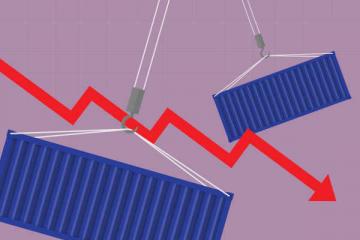There’s been a lot of talk about the Great Resignation, the phenomenon of workers telling their bosses to take this job and shove it – literally, since telling off the boss on video is becoming an Internet sensation. But looked at more closely, some are now calling it a Great Reshuffle. People aren’t actually leaving the workforce, although there is some of that, so much as reassessing what they want to do, where they want to work and who they want to work for. One company’s great resignation is another company’s great new associate.
There is a corollary going on in supply chains, as global manufacturers rethink where they source materials and where they manufacture their products. Some are calling this re-shoring, or bringing back production from Asia to the United States – or Asia to Europe if that’s your home base.
It’s not that simple, which is the reason I’m calling it the Great Supply Chain Redesign. It’s being driven by a variety of factors: One that we hear a lot is the need to get closer to the customer, especially for e-commerce companies, but I think you can draw a line back to the record number of suppliers who went out of business following the Great Recession in 2008; the Japanese tsunami of 2011, that exposed the risk of putting all of your eggs in one basket in one geography, followed by earthquakes in the Ring of Fire; the tariff and trade wars that were launched in 2018 and are still being fought, and finally, of course, the pandemic.
Last fall, Achim Meyer, the managing director for logistics at HARTING Technology Group, a German manufacturer of automation products, used the term localization to describe his company’s go-to-market strategy. “We want our production and logistics located where are customers are located,” he said.
More recently, I had a conversation with Guru Bandekar, the chief supply chain officer for global tools & storage at Stanley Black & Decker. He also used the term localization to describe a strategy that he defined as “make where we sell and buy where we make.”
Bandekar is responsible for the procurement and deployment of $14 billion worth of materials. And, as CSCO, he is ultimately responsible for the planning, manufacturing and distribution of 85,000 products across some 100 plants and 45 distribution centers around the globe. The manufacturer operates some of those facilities and works with contract manufacturers and 3PLs in others. Bandekar also partners with logistics providers such as Kuhn & Naegle for ocean shipments and UPS for air and ground transportation.
Like Meyer, he said the concept behind the toolmaker’s strategy is to locate manufacturing capacity near the markets served by the toolmaker, and, whenever feasible, to purchase materials and parts from suppliers close to the point of manufacturing. Between 60-and-70% of materials purchased are part of the localization strategy. “We realize that a lot of raw materials and inputs are in Asia,” he said. “So, our strategy isn’t to make all of our steel in the United States or Europe, but to make the end-to-end supply chain as close to the markets served as possible.” He added that Stanley Black & Decker sources about 60% of its materials this way.
While supply chain redesign has been a pandemic theme, Bandekar told me that it predated COVID at Stanley Black & Decker, extending back to the start of the trade wars, if not before. “When I joined the company in December 2019 as chief procurement officer, the localization strategy was already underway,” he told me. “When tariffs were instituted, our supply chain was heavily centered in Asia, and management realized the need to develop resilience by near shoring.” Bandekar said his task was to strengthen that effort. He was directed to deliver more productivity by using analytics to get visibility into procurement data and to increase resiliency by developing new sources of supply near manufacturing centers and strengthening existing supplier relationships.
He added that Stanley Black & Decker is asking 20 of its suppliers to set up factories in the U.S. and Mexico and is investing alongside its suppliers. It is doing something similar in other geographies.
That approach to localization could define the future of manufacturing.
In addition to localization, I was interested in how Stanley Black & Decker has negotiated its way through the pandemic. One of the most immediate challenges has been transportation, where costs have skyrocketed to four times the negotiated price and lead times are twice what they used to be. Bandekar said that the work his team had already done on visibility, data and analytics served them in these challenging times.
For example, some containers are now outfitted with IoT devices, such as RFID tags, that enable the toolmaker to know on which ship a container is located, where on the ship it’s stored, what’s inside the container and the PO’s associated with that inventory. With that level of detail, the team can understand things like where a container might be in the unloading process when it docks. In addition to the description of the goods, the analysis informs the team about the gross sales value at risk and the margin value of the goods inside the container. That level of data plus analytics allowed Stanley Black & Decker to stand up a transportation control tower in Maryland that helps us understand where its finished goods are located, including what inventory is in transit by mode. “We can use that information to satisfy customer needs and prioritize the transportation mode based on factors such as speed, cost and profit margins,” Bandekar said.
He added, “if we see a demand pattern shifting and a product in high demand will take 81 days to get from China to the West Coast, we can pivot our manufacturing lines, or we can put it on a faster boat; we can use air freight; or we can put it on the rail from Asia to Germany. We’re using transloading to move product to a port that is less busy, like Charleston versus Savannah.”
Perhaps the biggest change in the Great Supply Chain Redesign at Stanley Black & Decker is the overall approach to supply chain management. “Our supply chain was very simplistically designed to solve for productivity,” he said – like most manufacturers. “Now, we’re solving for productivity, agility and availability. We have to be cost competitive, but resiliency is now at the center of what we’re trying to solve for, and we’re focused on availability and agility as well. Trying to balance those three is critical.”
SC
MR


Latest Supply Chain News
- How S&OP provides the answer to in-demand products
- AI, virtual reality is bringing experiential learning into the modern age
- Humanoid robots’ place in an intralogistics smart robot strategy
- Tips for CIOs to overcome technology talent acquisition troubles
- There is still work to do to achieve supply chain stability
- More News
Latest Podcast

 Explore
Explore
Latest Supply Chain News
- How S&OP provides the answer to in-demand products
- AI, virtual reality is bringing experiential learning into the modern age
- Humanoid robots’ place in an intralogistics smart robot strategy
- Tips for CIOs to overcome technology talent acquisition troubles
- There is still work to do to achieve supply chain stability
- Blooming success: The vital role of S&OE in nurturing global supply chains
- More latest news
Latest Resources

Subscribe

Supply Chain Management Review delivers the best industry content.

Editors’ Picks




